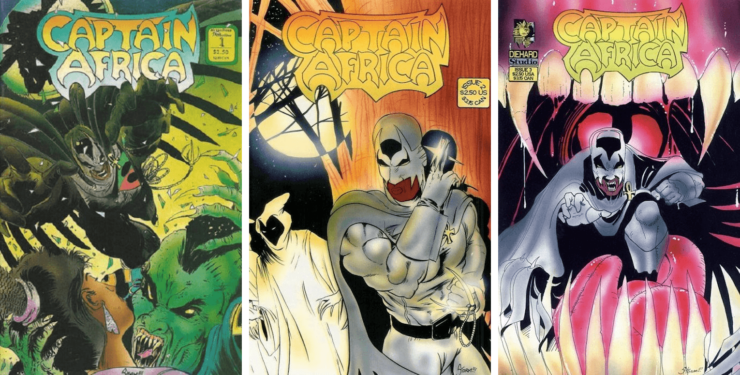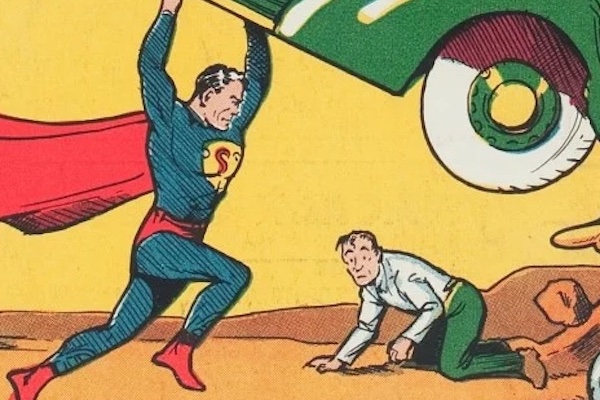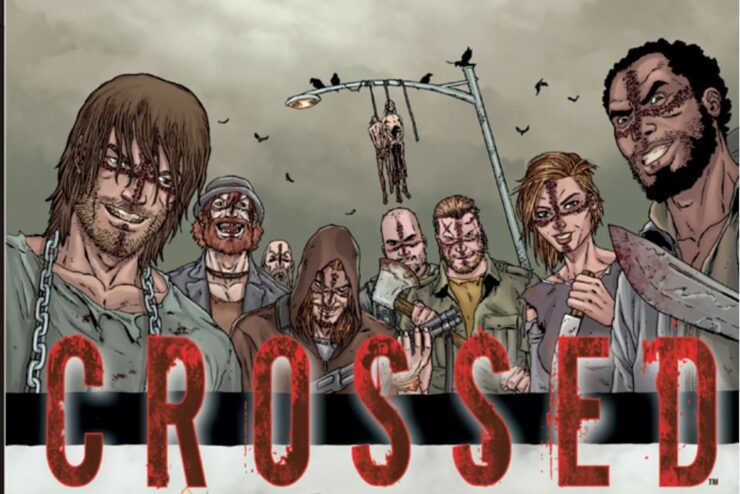In September of 1988, the New York Times published an article by James Brooke, an American journalist and then bureau chief at Abidjan, Ivory Coast. “Goodbye to Tarzan,” the headline read. “Meet Captain Africa.”1 For many Americans—and in essence, many readers the world over—Captain Africa was the first contact with a comic and superhero written, illustrated and published by Africans domiciled on the continent. The first African #ownvoices superhero comic to go global, if you will. At the time of the New York Times article, Captain Africa had already been in publication for close to a year, but no matter. It was new, fresh, pan-African, and worthy of attention.
A few years into the 1990s, Captain Africa slowly waned, before vanishing completely. Along with its creator, Ghanaian Andy Akman, and its Nigerian publisher, African Comics Limited, almost every facet of its existence is now lost. Yet its influence on more recent superheroes from the continent lingers, and continues to shape work written and produced by its own people today.
The Making of the African Superhero
Captain Africa might have been the first #ownvoices African superhero to go global, but he wasn’t the first African superhero. He wasn’t even the first Captain Africa. In 1955, American producer and director, Spencer Gordon Bennet wrote and produced a film serial titled The Adventures of Captain Africa, starring the original lone ranger, John Hart. Two American agents attempt to stop a takeover of an unnamed African nation, aided intermittently by a “masked jungle lord,” where the masked jungle lord is Captain Africa. So yes, the initial Captain Africa was white, and he still wasn’t the protagonist of his own story.
Prior to Captain Africa (the real one), African hero stories, super or otherwise, happened in three ways. First, there were those made by non-Africans about Africa, for non-African readers like them. Tarzan and King Kong are good examples of that. Comics-wise, the original Mytek the Mighty (for which I recently wrote a remake for 2000AD) fell in this category. Most of their themes peddled colonialist attitudes toward the continent and spotlighted white saviour narratives, even when they featured powerful African characters.
Then there were those conceived by non-Africans for Africans. The writing, illustration and production were done by white-owned companies abroad or on the continent, and sometimes, a tiny slice was outsourced to African writers, artists or printers. Powerman (1975-77, published by British-owned Pikin Press/Pican Publications in Nigeria) and Mighty Man (1976-1977, developed by Richard Manville’s New York-based Afri-Comix, but published by South African J. van Zyl Alberts for the African market) are two good examples.2 In the case of Powerman, the aim was to deviate from the reprints of British comics with white-only characters that made up all of the anglo West-African comic market, and make something easier for the not-always-literate-in-English local populace to digest. For Mighty Man, it was the same—to usurp the Marvel and DC comics rebranded for the African market. But all of Manville’s production was US-based, and funded by American Republicans, who placed strong restrictions on what could be published. There could be no stories challenging the government, for instance, or any resistance against colonialism or slavery3. This was especially notable because South Africa was still in the throes of Apartheid at the time.
But despite all of this, locally produced superhero comics, written by Africans for Africans, still thrived. Many of these differed from today’s comics by standard or approach, but they were sufficient for the time. Karin Barber, for instance, in “Popular Arts in Africa,” discussed the crossover of Marvel heroes with Twi folktale figures to produce unique mimeographed comics in Accra and Kumasi in the 1970s4. The stories featured “English interspersed with Twi,” and “combinations like Spider-man and Ananse, but the message that was conveyed was not borrowed either from the Western comic.5” Characters discussed their pasts and presents, especially bemoaning abuse by politicians and the military. Ghanaian deities and folktale figures discussed these plights with Marvel figures, with some having to take refuge in the towns and villages after being hunted by security forces. Sometimes, revolts led by these characters brought the government to see their errant ways.
Many locally-produced comics tackled matters of political and civil unrest in this way. So, it was no surprise when Andy Akman, a Ghanaian living in Nigeria at the time, decided that enough was enough. No more fake Captain Africa. No more Powerman. No more Mighty Man. Here comes the real Captain Africa.
The Rise and Fall of Captain Africa
Dressed in a green suit with a map of Africa emblazoned Superman-style on his chest, Captain Africa was arguably the most popular African-created superhero in anglo West Africa during his time. A solar-powered cape enabled him superspeed flight, and his mission was simple and noble: “To fight all evil and dark forces that threaten Africa and the whole world.”6 Usually, these threats involved issues that affected contemporary Africans of the time—violent crimes (especially against children), and organized crime with or without government backing. On his off days, he was a successful businessman. When asked about this in the New York Times article, Akman’s response was that Africans did not trust dissent that came from those who owned little, because their protests might simply be a way to enrich themselves after deposing current oppressors7. This was likely based on the still-fresh colonial handover experience, where many African countries were taken over by former dissidents who saw the new, fledgling nations as avenues for self-enrichment.

In speaking to James Brooke, the president of African Comics Limited and publisher of Captain Africa, Mbadiwe Emelumba, doubled down on the comic’s anti-colonial stance. “We have our own culture, our own heritage,” he said. “It’s important to defend against cultural colonialism.”8 This ethos was echoed across the board. Brooke noted how Akman focused the superhero’s exploits on urban Africa, eschewing its more recognized and globally touted rurality, to which Akman replied, “Gone are the days of Africans wearing raffia skirts. We are living in modern houses. He must be a Superman, not a Tarzan.”9
Sadly, it was these same systemic issues the stories tackled that brought about the comic’s downfall. In speaking with University of Birmingham scholar Tessa Pijnaker, science fiction author Tade Thompson noted that the political turmoil and military coups in 1980s Nigeria affected the country’s relationship with the rest of the world, which together with rising corruption in the customs agency, caused import-export to dwindle10 . This meant comics became less accessible, and Captain Africa lost its international role and had to pivot into something more local. Vanguard Newspaper, a then avant-garde fresher in the national news market, took up the Captain Africa mantle around 1983/4 and began to publish 3-panel excerpts serially on its back page. They retitled it Kaptain Afrika to divest from the earlier comic. The Captain’s exploits remained the same, and the themes stood their ground. Somewhere within this time, the writing and illustration moved on from Akman, and by the time I read them as a child in the 90s, freelance artists hired by Vanguard Newspaper had taken over. Soon after, the serial was dropped completely, and Captain Africa was lost for good.

Questions have been raised since then about the whereabouts of Akman or the comic. In 1995, Canadian artist Scott Dutton republished an issue of the comic in his Global Gazette Special, with a note explaining how he navigated the process of getting the then-invisible Akman’s permission to do so. The issue (#15) was titled Nigeria’s Captain Africa: The Secret Society11. In it, Captain Africa rescues a boy called Bonny, son of a powerful member of a secret society intent on sacrificing him to “the dark forces behind the society.” The society’s members give hot chase and Captain Africa has a very tough time dispatching them, demonstrating how, just like Black Panther and many other African superheroes, technological advancements from beyond the continent may only reside hand-in-hand with the already existent mystical, rather than render it useless or powerless. This is particularly pertinent as secret societies, violent or not, are a staple of African society, and are still revered to this day, regardless of technology.
Captain Africa’s legacy in today’s African #ownvoices comics
Despite Captain Africa’s disappearance into oblivion, the comic sowed a seed that began to bloom, sprouting various similar works produced by Africans on the continent. Akhokhan, a strip that appeared in three of Kenya’s major newspapers between 1995 and 2011, was written by Frank Odoi, a Ghanaian living in Kenya. It featured “a misunderstood superhero, Akokhan and his nemesis Tonkazan, who intends to dominate Africans and their religious life.”12 The anti-colonialist themes remained strong, and for as long as it lasted before Odoi’s death in 2012, Akhokhan was “one of the most widely read and circulated of East Africa’s comic superheroes.”
More recently, independent artists and comic-only publishers have sprung around the continent to continue what Captain Africa and Akman started. Nigeria’s Comic Republic sports its own Captain Africa adjacent in Guardian Prime. Created by Jide Martin and Wale Awelenje, the titular hero sports the green-and-white colours of the nation—and arguably, the continent—while equipped with superhuman powers of flight, strength, speed and invulnerability. Guardian Prime is only one of various in Comic Republic’s stable of heroes, which include other characters like Avonome, Eru, Jade Waziri, Orishabunmi and Iretis Bidemi & Moremi.
Roye Okupe’s YouNeek Studios is another emergent studio working toward not just #ownvoices African characters and comics but also animations, as piloted in its debut animation, Malika: Warrior Queen. Prior to Malika, Okupe published his debut graphic novel, E.X.O: The Legend of Wale Williams in 2015, and it made all the big media rounds.
Elsewhere, Kugali Media, based in London, publishes Bill Masuku’s Razor-Man about a vigilante who tackles crime on Harare’s streets in Zimbabwe. In Ghana, Farida Bedwei, a software engineer with cerebral palsy, teamed up with game-developer-turned-publisher Leti Arts to create the continent’s first disabled superhero in Karmzah. The comic follows Morowa Adjei, “an archaeologist who lives with cerebral palsy, and who amazingly gains superpowers through her crutches enabling her to be able to become her superhero alter ego, Karmzah.”13 Even the stories of heroes created by non-Africans are now steadily being told by storytellers with roots in the continent, as evidenced by Nigerian-American sci-fi author Nnedi Okorafor writing the newer incarnations of Shuri and Ghanaian-born fantasy author Roseanne A. Brown tasked with a forthcoming Black Panther graphic novel, both for Marvel.
Indeed, Marvel’s Captain America might be the world’s most popular captain, and the Black Panther might be Africa’s most exported superhero, but Captain Africa walked so today’s African #ownvoices comics could run. Africans from the continent, telling stories of their specific struggles and drumming up their own heroes to swoop in and save the day, know this: that the influence of the steering hand of Andy Akman’s Captain Africa cannot be divorced from the promising global revival of African superheroes today.
 Suyi Davies Okungbowa is a Nigerian author of stories featuring African(esque) gods, starships, monsters, detectives and everything in-between. His godpunk novel, David Mogo, Godhunter, is out from Abaddon in July 2019, and currently available for pre-order. His internationally published fiction and nonfiction have appeared in Lightspeed, Fireside, Apex, Podcastle, The Dark, and other periodicals and anthologies. He is an MFA candidate in Creative Writing at the University of Arizona, where he teaches writing to undergrads. He tweets at @IAmSuyiDavies and is @suyidavies everywhere else. Learn more at suyidavies.com.
Suyi Davies Okungbowa is a Nigerian author of stories featuring African(esque) gods, starships, monsters, detectives and everything in-between. His godpunk novel, David Mogo, Godhunter, is out from Abaddon in July 2019, and currently available for pre-order. His internationally published fiction and nonfiction have appeared in Lightspeed, Fireside, Apex, Podcastle, The Dark, and other periodicals and anthologies. He is an MFA candidate in Creative Writing at the University of Arizona, where he teaches writing to undergrads. He tweets at @IAmSuyiDavies and is @suyidavies everywhere else. Learn more at suyidavies.com.
[1]Brooke, James. “Goodbye to Tarzan, Meet Captain Africa.” The New York Times, The New York Times Company, 27 Sept. 1988, www.nytimes.com/1988/09/27/arts/goodbye-to-tarzan-meet-captain-africa.html.
[2]Pijnaker, Tessa. “African Superheroes in the 1970s and 1980s: a Historical Perspective.” Africainwords.com, Africa in Words, 28 May 2019, africainwords.com/2018/06/11/african-superheroes-in-the-1970s-and-80s-a-historical-perspective/.
[3]Wood, Nick. “Soweto's Super Man: 'Mighty Man' and the Mid-70s in South Africa.” South African Comic Books, George Van Der Riet, 12 Oct. 2011, southafricancomicbooks.blogspot.com/2011/10/sowetos-super-man-mighty-man-and-mid.html.
[4]Barber, Karin. “Popular Arts in Africa.” African Studies Review, Cambridge University Press, Vol. 30, No. 3, September 1987, pp 1-78. http://www.jstor.com/stable/524538
[5]Ibid. 1
[6] Ibid.
[7] Ibid.
[8] Ibid.
[9] Ibid.
[10]Pijnaker, Tessa. “African Superheroes in the 1970s and 1980s: A Postscript.” Africainwords.com, Africa in Words, 14 Oct. 2018, africainwords.com/2018/10/08/african-superheroes-in-the-1970s-and-1980s-a-postscript/.
[11]Dutton, Scott. “Nigeria's Captain Africa!” Facebook, Comic Bandit, 7 Apr. 2012, www.facebook.com/media/set/?set=a.400356819984123.98631.148049485214859&type=3
[12]Duncan Omanga (2016) ‘Akokhan returns’: Kenyan newspaper comics and the making of an ‘African’ superhero, Journal of African Cultural Studies, 28:3, 262-274, DOI:10.1080/13696815.2016.1163253
[13]Muchiri, Maggie. “Karmzah Comic Official Release.” Leti Arts, Leti Arts, 5 Nov. 2018, www.letiarts.com/uncategorized/karmzah-comic-official-release/.















Thanks for this article. I learned a lot that I had not been aware of.
This is fantastic, I always want to know more about African comics and this was very helpful.
Really interesting!
Great article! Thank you.
This is great. I had never heard of these comics.
Side note: That Captain Africa serial was originally intended to be a Phantom serial, but the studio lost the rights to the character, so they changed the name and tweaked the costume a bit, but the resemblance is obvious.
Very interesting piece.
And particularly interesting for the contrast between Captain Africa and Black Panther.
One was invented by Africans in Africa, for Africans to read, and so was concerned with reflecting how modern Africa actually is; so he operates in an urban society, he reflects the real roots of African dissent and so on.
The other was invented by white Americans in America for Americans to read and reflects a very different idea of modern Africa.
Thanks for this! I’m going to see if it’s possible to check out Karmzah through the app.
It seems from the linked Hollywood Reporter page that Roseanne Brown’s graphic novel for kids will focus on Shuri–I look forward to that! I was sorry to see Nnedi Okorafor’s Shuri series end.
For Captain Africa to be an accurate counterpart to Captain America, he should have in his uniform the colours and motifs of a *single* country in all Africa, ignoring the rest of the continent
@8. Jordi Richart: In this context the Good Captain seems to be named more in the spirit of Captain Marvel (I’m thinking of Billy Batson, but Monica Rambeau or Carol Danvers are equally reasonable points of reference). (-:
@6. ajay: It’s nice to see that both seem to have been accepted and liked by audiences – after all, just because a character is created with a specific audience in mind doesn’t mean they have to be the exclusive property of that community! (Also, someone really should get to work on a Captain Africa/Black Panther crossover – two superheroes mean Double the Adventure and Double the JUSTICE!).
…
Also, am I the only one who wants to see how Lord Greystoke would react to all these new-fangled superhumans and their apparently bottomless appetite for spandex? (One gets the impression of an elderly gentleman very politely ignoring the fact he’s orders of magnitude less powerful than all the new kids on the block and quite casually doing his own thing while they handle the Heavy Work*).
*One would assume that Tarzan tends to stay in the background these days, if only because he’s got to be the better part of a century old and all those adventures take their toll, but I expect he can still be found by those who know where to look … or those who can persuade Dame Jane Goodall to point the finger towards her old correspondent.